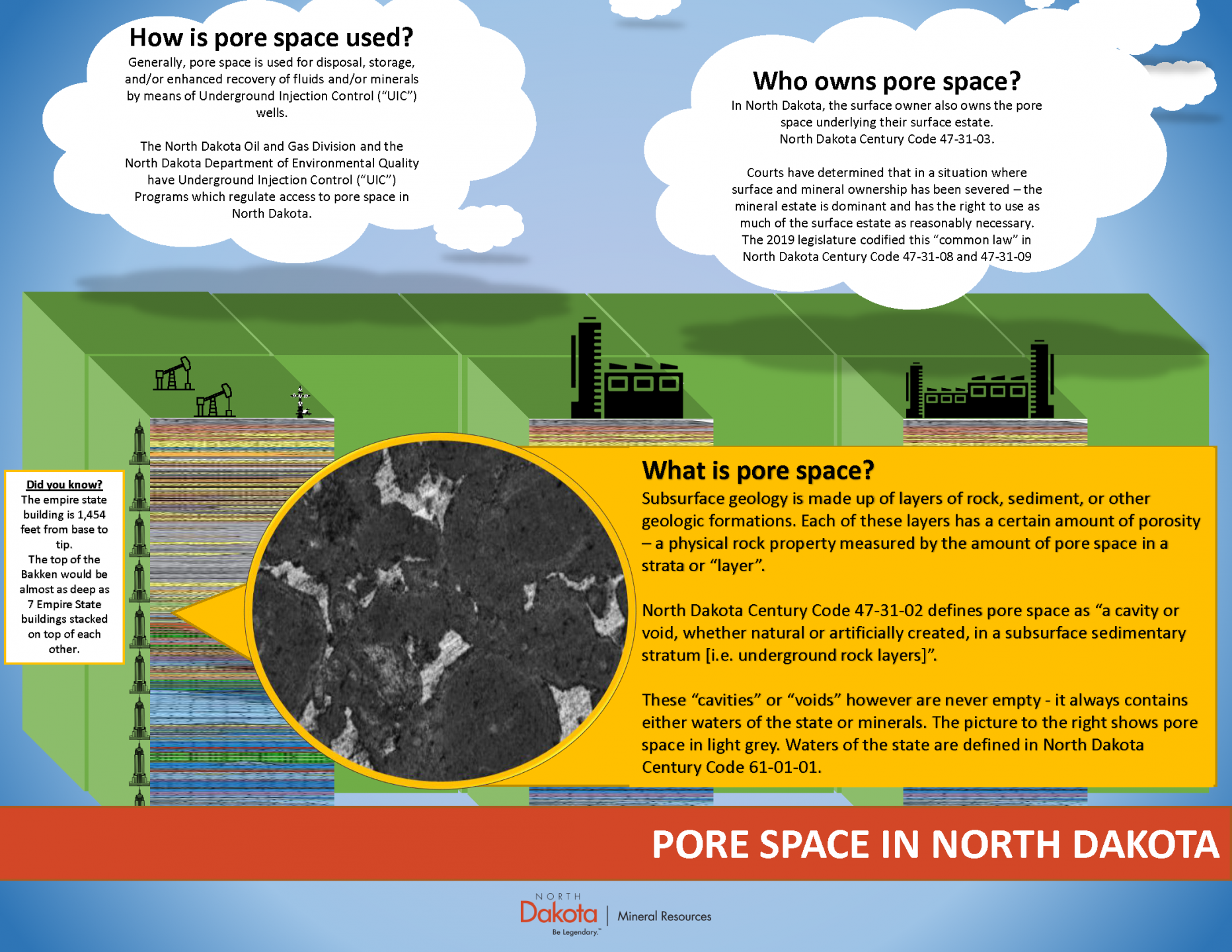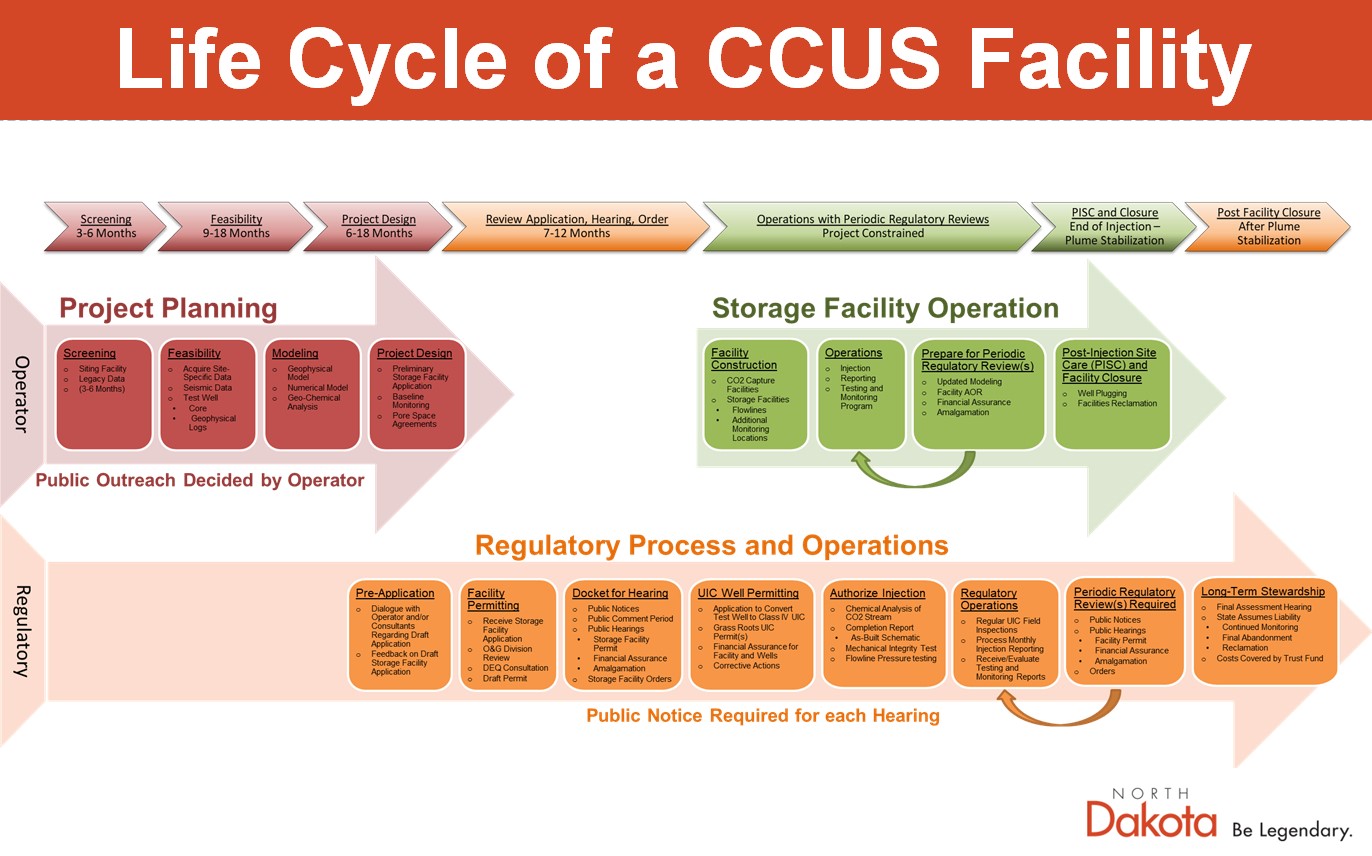The North Dakota Oil and Gas Division has primary regulatory authority (Primacy) over Class VI injection well activities in the State of North Dakota.
On December 10, 2010, the EPA finalized federal requirements for the geologic storage of carbon dioxide under the authority of the federal Safe Drinking Water Act's Underground Injection Control (UIC) Program, creating a new class of injection well, Class VI.
These requirements, also known as the Class VI Rule, are designed to protect underground sources of drinking water based on the UIC Program regulatory framework with modifications to address the unique nature of carbon dioxide injection for the primary purpose of long-term storage.
The EPA is the acting regulatory authority in all States except those granted primacy.
Under the federal UIC program each State must apply for primacy by demonstrating, through application, to the EPA that its Class VI UIC Program (ND Century Code Chapter 38-22 and ND Administrative Code 43-05) is at least as stringent as the federal standards. On June 21, 2013, the official North Dakota Class VI primacy application was submitted.
North Dakota was granted primacy by the EPA of Class VI wells on April 24, 2018.
CO2 Storage Facility and Class VI Permits
Permits Issued
- Operator: Summit Carbon Storage #1, LLC
- TB Leingang Broom Creek Storage Facility, Mercer, Morton, and Oliver Counties
- Operator: Summit Carbon Storage #2, LLC
- BK Fischer Broom Creek Storage Facility, Mercer and Oliver Counties
- Operator: Summit Carbon Storage #3, LLC
- KJ Hintz Broom Creek Storage Facility, Oliver County
- Operator: DCC West Project LLC
- DCC West Center Broom Creek Storage #1, Oliver County
- Operator: Blue Flint Sequester Company, LLC
- Blue Flint Underwood Broom Creek Storage Facility #1, McLean County
- Case 29888 - Certificate, draft permit, fact sheet, and storage facility permit application
- Order 32474 - Geological storage of carbon dioxide
- Order 32475 - Amalgamation of the storage reservoir
- Order 32476 - Determination of financial responsibility
- Order 32757 - Field and pool
- MAG 1 (WF 37833) - Class VI injection permit
- Blue Flint Underwood Broom Creek Storage Facility #1, McLean County
- Operator: Dakota Gasification Company
- DGC Beulah Broom Creek Storage Facility #1, Mercer County
- Case 29450 - Certificate, draft permit, fact sheet, and storage facility permit application
- Order 32250 - Geological storage of carbon dioxide
- Order 32251 - Amalgamation of the storage reservoir
- Order 32252 - Determination of financial responsibility
- Order 32756 - Field and pool
- Coteau 1 (WF 38379) - Class VI injection permit
- Coteau 2 (WF 38916) - Class VI injection permit
- Coteau 3 (WF 38917) - Class VI injection permit
- Coteau 4 (WF 38918) - Class VI injection permit
- Coteau 5 (WF 39418) - Class VI injection permit
- Coteau 6 (WF 40027) - Class VI injection permit
- DGC Beulah Broom Creek Storage Facility #1, Mercer County
- Operator: Minnkota Power Cooperative, Inc.
- Minnkota Center MRYS Broom Creek Storage Facility #1, Oliver County
- Minnkota Center MRYS Deadwood Storage Facility #1, Oliver County
- Operator: Red Trail Energy LLC
- Red Trail Richardton Ethanol Broom Creek Storage Facility #1, Stark County
- Case 28848 - Certificate, draft permit, fact sheet, and storage facility permit application
- Order 31453 – Geological storage of carbon dioxide
- Order 31454 – Amalgamation of the storage reservoir pore space
- Order 31455 – Determination of financial responsibility
- Order 32753 - Field and pool
- RTE 10 (WF 37229) - Class VI injection permit
- Red Trail Richardton Ethanol Broom Creek Storage Facility #1, Stark County
CO2 Monthly Storage Reporting
Where can I find monthly CO2 storage reporting forms?
Storage facility operators must submit monthly reports (Form 26 and Form 26A) to report the mass of carbon dioxide (in tonnes) and total stream volume (in MCF) which has been stored in their facilities. Blank forms can be downloaded by using the links below.
Cumulative CO2 Stored by Storage Facility
Download the PDFs below to view monthly injection data for the following facilities:
- Blue Flint Underwood Broom Creek Storage Facility #1
- DGC Beulah Broom Creek Storage Facility #1
- Red Trail Richardton Ethanol Broom Creek Storage Facility #1
Note: Monthly injection data is due on or before the fifth day of the second succeeding month (for example March data is due by the May 5th). The PDFs above will be updated by the 19th of each month.
Frequently Asked Questions
What do the titles across the top represent?
From left to right: Name of the storage facility, Name of the storage operator, Name of the formation storage is occurring, and Field and pool name.
Why are some fields blacked out?
The CO2 storage reporting forms were recently updated in 2024 and as part of that update new parameters are now being collected, such as total injection time and maximum values for injection rate, wellhead pressure/temperature, and bottomhole pressure/temperature. The blacked out fields are dates prior to the 2024 update where no data is available.
What is the difference between CO2 Mass and Stream Volume and why is it being reported in different units?
CO2 Mass represents the molecular mass of carbon dioxide in metric tons (tonnes) that is being stored into the storage formation. This value accounts for the purity of CO2 in the injection stream as it represents only the mass of CO2 and not the mass of the total injection stream. CO2 mass in tonnes is used to calculate storage facility fees pursuant to NDAC Section 43-05-01-17 and IRS 45Q tax credits.
Stream Volume represents the total volume of the injection stream in standard thousand cubic feet (MCF). This volume represents the total stream volume, including the CO2 and other impurities/incidentals that have been stored into the storage formation. The total injected stream volume is important for modeling the movement of the CO2 and its pressure front within the storage formation.
What do stabilized and maximum values represent?
Stabilized values represent what is observed during stable injection conditions. These values are obtained by first removing measurements during down time (no injection is occurring) and outliers that may occur during start up and shutdown operations.
Maximum values represent the measured instantaneous maximums seen during operations.
CO2 Storage Facility Financial Responsibility Forms
Where can I find financial responsibility forms for CO2 storage facilities?
This form is to be used where the financial instrument is a surety bond or third-party insurance policy.
This form is to be used where the financial instrument is a cash bond, escrow account, trust fund, or other approved method.
Where can I find well bond forms for the drilling of stratigraphic test wells, Class VI injection wells, and UIC Monitoring wells?
Each well must be on a single well surety or cash bond to receive an application to drill. The well bond must remain in place until the well is either plugged and abandoned and site reclaimed or until the CO2 storage facility financial instruments are in place. A well bond may be proposed to be used to cover components of the CO2 storage facility financial responsibility.
Frequently Asked Questions
What is a Class VI well?
Class VI wells are used to inject carbon dioxide (CO2) into deep rock formations. Underground Injection Control (UIC) Class VI wells inject CO2 for long-term storage to reduce emissions to the atmosphere.
This long-term underground storage is called geologic sequestration (GS).
Geologic sequestration refers to technologies to reduce CO2 emissions to the atmosphere.
What is the difference between a storage facility permit and Class VI injection well permit?
The permitting process in North Dakota is different from the federal permitting process.
In North Dakota a storage facility permit (SFP) is approved first, by signed Industrial Commission orders, which authorize the creation of the storage facility area, the amalgamation of pore space, and financial responsibility requirements. These orders do not authorize injection into the storage facility area. The storage facility operator must still apply for a Class VI well permit once they have an approved SFP. Upon completion and testing of the well they are granted authorization to inject into the well by an approved NorthSTAR sundry.
Information on permitting stratigraphic test wells and seismic projects can be found under Publications & Related Links.


